
Las 5 mejores técnicas comprobadas de gestión del control de multitudes (actualización 2020)
Queues are often overlooked in our everyday lives. We stand in them while waiting to purchase groceries, buy tickets to a movie, enter a sporting event, or even use an ATM. Depending on the location, time of day, and other factors queues vary a lot, going from a few people in line to congested and chaotic. During the coronavirus pandemic of early 2020, service and retail queuing techniques gained national attention, with an increased focus on protecting waiting customers and the employees who serve them. Using tried and true crowd control management techniques, creating safe and efficient queues is possible.
While many retailers are turning to temporary safety precautions, the need to provide queuing and barrier solutions that keep customers safe, organized, and moving efficiently will far outlast the pandemic and should be addressed with a long-term strategy in mind. Designing an efficient queue that provides safe social distancing and improves customer satisfaction is simple. Utilizing the following crowd control techniques – wayfinding optimization, queue management, temporary closures, rapid deployment, and customer flow management – can go a long way in producing order and restoring a pleasurable experience for your customers.
Here are top 5 crowd control management techniques:
- 1. Wayfinding Optimization
- 2. Queue Management
- 3. Temporary Closures
- 4. Rapid Deployment
- 5. Customer Flow Management
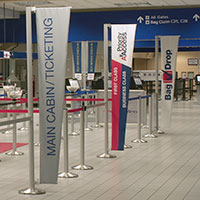
1. Wayfinding Optimization
A curbside pickup area, hospital check-in desk, museum entrance, or retail returns counter, are all examples of important destinations within your venue that attract multitudes of people. To guide your visitors there, you’ll need strong wayfinding techniques.
Wayfinding is a full-fledged field of expertise; in the realm of crowd control, wayfinding techniques use clear signage and markers to ease navigation—and avoid the kind of congestion that can accumulate when visitors are confused. In introducing great wayfinding techniques to your venues, you’ll also enhance your brand—and ensure a great customer experience. Let the following principles guide you as you optimize your wayfinding.
Clearly mark their journey
Your visitors need to know where to go and how to get there. At the same time, giving them too much information all at once confuses things. That’s why signs to aid wayfinding should be clear and minimal. Use simple, straightforward language—and cut out the extra words. The shorter and clearer your message, the quicker your customers can find their way through your area…and the happier they’ll be.
Clarity applies to more than just signage. Map out defined areas for your visitors—and guide them on their journey. You can mark points along the way like where the queue starts and where it ends (where customers stop and wait to be called to the cash registers), or utilize floor stickers to provide visual clues to safe social distance spacing. Consider attaching post top signs to your queue stanchions to provide additional clarity.
Part of wayfinding is telling visitors where not to go, too. To create walkways and mark areas off-limits, use post and panel barriers with signs showing arrows, symbols, or clear directives. Signs marking established areas, like checkout, seating, and lounges, can help your visitors know when they’ve arrived.
Make your signage consistent
Consistency helps reduce confusion and smooth out your customers’ wayfinding journey. Additionally, wayfinding signs are a perfect opportunity to showcase your brand; by keeping your signs consistent in color scheme, font, design, and tone, you can present a clear, unified company image to all visitors.
Just don’t prioritize brand promotion over clarity: it’s far better to present your visitors with a clear, simple message than it is to tack on your brand logo or signature catchphrase. If you serve up that seamless wayfinding experience, customers walk away with a better impression of your brand than they would get from a logo.
Think about size and readability
TSA Precheck banner signs immediately tell pre-qualified airport customers where to go for their security checks. Why do they work so well? They tend to be large, bright, and crystal clear. You can see them from a mile away, and the language is simple, the letters big and bold. For wayfinding in large or especially crowded areas, you may need an extra-large sign to convey your message. Banner signs like the kind offered by Lavi can help dispel any confusion immediately and provide your customers with clear direction.
To make sure everyone can read your signs, consider providing multilingual text. Or, if possible, include a clear image that shows customers what to do without having to read.
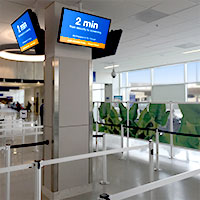
2. Queue Management
Lines are a natural part of just about any shopping, travel, or entertainment experience. But not all lines are created equal: some are tedious and stressful—and others are not. For example, you can distract your visitors from the monotony of a long queue with in-line entertainment and merchandise. Better yet, shorten their wait time by changing up your queuing system.
As a Cornell University School of Hotel Administration recently discovered, giving customers something to do while they wait can reduce boredom. But ultimately, most customers want a shorter wait.
Let’s look at some modern approaches to queue management.
The single line model—faster and fairer
When Whole Foods first came to Manhattan in 2001, they did something unconventional. Rather than queuing customers into separate lines behind each checkout aisle, Whole Foods organizes customers into a single line, each of which feeds into a bank of cash registers. Once customers reach the front of their line, an electronic prompt—a screen with sound—guides them to the next available cashier. This single line moves customers through checkout over five times faster: the New York Times reporter tallied a 4.5-second average for each checkout vs. 19.6 seconds at Trader Joe’s. And the innovation paid off—literally. Within six years of opening, Whole Foods became the top-selling Manhattan grocery store chain, as the Times reported.
Compared to the multiple line model, single line queues reduce customers’ wait time by an average of 30%. In any line, a customer risks getting stuck behind a fussy customer or a slow cashier. But in a single line, the law of averages evens out any bottlenecks.
But that’s not where the benefits of a single line end. As in traffic lanes on a highway, customers who wait in one of multiple lines often struggle with the perception that other lines are moving faster. Plus, customers universally hate it when people cut. A single line model eliminates those problems—now it’s first-come, first-served. Not only is it faster, it’s fairer.
Additionally, providing a single line queue helps to provide a safe social distance for your customers and employees. Instead of lining up in multiple lines near each register, customers are kept safely away from checkout employees until it is their turn. Additionally, floor stickers and well-placed signage provides customers with visual cues as to where to stand to maintain a safe social distance from each other. Single line queues that use switchbacks can benefit from germ barriers between adjacent rows, physically shielding people who may be standing too close to one another.
To make your single line move even faster, and to minimize customer confusion over which registers are open, try Qtrac Electronic Queuing. Using digital signage and station lights, electronic queue management systems direct customers to the next available agent so the line can continue moving seamlessly.
Virtual queuing—the modern way to wait
Or here’s a thought: just skip the physical line altogether. Fast-serve restaurants like Shake Shack use a basic form of virtual queuing: customers receive a buzzer—and wait for it to buzz.
Other restaurants, like Panera, have taken virtual queuing even further. Panera went from vibrating pagers to touchscreen ordering. Customers seat themselves and wait for their food to be brought out to them.
Qtrac virtual queuing takes the principle still further: customers don’t even have to be present to wait. They can schedule appointments from their home or car using their smartphone, then receive service when they arrive. Alternately, they can register from your venue with a simple scan of a QR Code, select the service they need, and receive a notification of their place in line. They then wait offsite until ready to be served.
Virtual queuing or mobile queuing isn’t just for restaurants. Whatever your industry, your customers will thank you for providing them with a safer queue and saving them from the tedious, time-wasting experience of physically waiting in line.
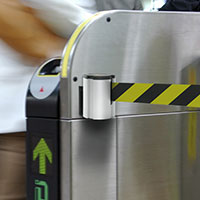
3. Temporary Closures
When you need to block off an area—whether for safety, cleaning, repairs, or renovation—you’ll want to clearly mark it so your customers aren’t confused. If you block access to a major passageway or facility, give your visitors a clear alternative: another restroom they can use or a different route they can take to reach their destination. Otherwise, you’ll end up with a lot of disgruntled customers.
Post and panel barriers stop people from getting past, and they also allow you to slide in signage that can be used to point customers another way or apologize for the inconvenience. Using our Shuttletrac Panel Cart, two or three staff can easily transport and set up 18 post and panel barriers at one time.
If you’re short on staff, try the Wall-Mounted Retractable Belt. Stored in canisters that hang on the wall, you can pull it out at a moment’s notice and block off passageways, staircases, aisles, or restrooms. Retractable belts often come in handy in retail when staff need to temporarily block off an aisle for cleaning, restocking, or reconfiguration and are available in permanent or removable mounting options.
A different option is a lightweight temporary retractable belt stanchion, such as the Tempest plastic stanchion. With handles built-in to the stanchion post, and a lightweight plastic body, it is easy for an employee to quickly set up a temporary barrier. Post top signage, custom belt messages and floor stickers can be added to help inform customers.
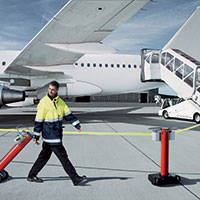
4. Rapid Deployment
Whether you need to control an influx of customers arriving for curbside pickup or block off a restroom with an overflowing toilet, a good rapid deployment strategy is key to crowd management. Sometimes rapid deployment means blocking access to an area—like the tarmac or a basketball court—in minutes. At other times, it means expanding your queue to accommodate unexpected large crowds. Whatever the reason, you’ll need two things for rapid deployment: equipment you can whip out in seconds, and a clear plan of action.
If your venue is large, store your rapid deployment supplies in various locations. That way you can quickly set them up in any area. When you need to move equipment quickly without a lot of manpower, use something like the Shuttletrac Stanchion Transport Cart. Easy to store and maneuver, the cart can carry 12 to 18 stanchions at a time.
For larger closures, such as portions of a parking lot for public testing centers, it may be more beneficial to use large-area temporary barriers, such as JetTrac Dual Portable Retractable Belt Barrier. Unique to Lavi, it has two retractable belts that each extend up to 65 feet to form the industry’s longest retractable belt barrier. A wheeled base makes it quick and easy for even a single employee to set up a temporary barrier within minutes, covering a distance of 130 linear feet—the same as over ten portable retractable belt stanchions.
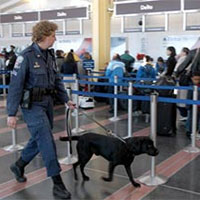
5. Customer Flow Management
Customer flow management encapsulates all of the techniques we’ve covered in this post. It involves wayfinding optimization, queue management, temporary closure strategies, and rapid deployment solutions. But customer flow management also includes overarching elements like the design and layout of your venue, , your signage strategy, and the way you handle crowd control on a broad scale.
When handled correctly, customer flow management brings a number of benefits, including—and this may be the most important of all—happier customers.
For example, in airports, a long wait is the single biggest factor in a negative customer experience. On the other hand, the highest factors for a positive experience include speed of baggage delivery, ease of check-in, and wait time for security checks—all things you can manage through customer flow.
Customer flow management is also about safety. According to traffic engineer John Fruin, “all types of crowds, even relatively small gatherings, can quickly become dangerous if not carefully managed.” Just Google “Black Friday stampede,” and you’ll see what can happen when crowds get out of hand. Other, more recent examples can be found by searching for COVID-19 queuing. In early March of 2020, retailers were faced with the daunting task of efficiently queuing large crowds of panicked shoppers while trying to maintaina safe environment.Businesses that used customer flow management were successful in maintaining order and safety both inside and outside of their facilities.
But the benefits of good crowd control aren’t just consumer-facing. A well-managed customer flow eases staff stress, elevating morale. It improves sales, too: happy customers spend more. By tracking customer flow, you can optimize marketing by placing displays and higher-priced items in areas that receive higher traffic.
Just look at Disney—the undisputed master of customer flow management. In 2017, Disney Parks welcomed 150 million visitors worldwide. Maybe it’s the happiest place on earth because it’s mastered the subtle art of crowd control. If you’ve visited any Disney Park, you’ve probably noticed things like FastPass (enabling their holders to get on a faster ride queue), in-line entertainment (like the elaborate queue for Disneyland’s Indiana Jones ride), and posted wait times: all designed to enhance the waiting experience.
Of course, what works for Disney may not be right for you. But find the crowd control techniques that fit your venue, and you’re one step closer to giving your visitors a safer, happier, more memorable experience.
SUSCRIBIRSE
Suscríbase para mantenerse al día con los nuevos productos, información y noticias sobre los recursos.
ENTRADAS DE BLOG RECIENTES
Theft at the Register: How Strategic Queue Design Protects Profits
Leer el artículo completoRapid Deployment Crowd Control: JetTrac Portable Barriers For The Biggest Spaces
Leer el artículo completo4 Psychological Reasons Your Customers Hate Waiting In Line
Leer el artículo completoFrom Bleachers To Bookstores: 4 Campus Crowd Control Solutions
Leer el artículo completo








